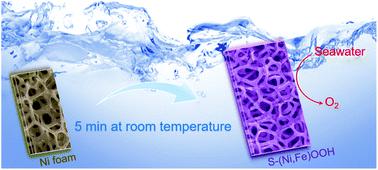当前位置:
X-MOL 学术
›
Energy Environ. Sci.
›
论文详情
Our official English website, www.x-mol.net, welcomes your
feedback! (Note: you will need to create a separate account there.)
Ultrafast room-temperature synthesis of porous S-doped Ni/Fe (oxy)hydroxide electrodes for oxygen evolution catalysis in seawater splitting
Energy & Environmental Science ( IF 32.4 ) Pub Date : 2020-06-02 , DOI: 10.1039/d0ee00921k Luo Yu 1, 2, 3, 4, 5 , Libo Wu 1, 2, 3, 4 , Brian McElhenny 1, 2, 3, 4 , Shaowei Song 1, 2, 3, 4 , Dan Luo 1, 2, 3, 4 , Fanghao Zhang 1, 2, 3, 4 , Ying Yu 5, 6, 7, 8 , Shuo Chen 1, 2, 3, 4 , Zhifeng Ren 1, 2, 3, 4
Energy & Environmental Science ( IF 32.4 ) Pub Date : 2020-06-02 , DOI: 10.1039/d0ee00921k Luo Yu 1, 2, 3, 4, 5 , Libo Wu 1, 2, 3, 4 , Brian McElhenny 1, 2, 3, 4 , Shaowei Song 1, 2, 3, 4 , Dan Luo 1, 2, 3, 4 , Fanghao Zhang 1, 2, 3, 4 , Ying Yu 5, 6, 7, 8 , Shuo Chen 1, 2, 3, 4 , Zhifeng Ren 1, 2, 3, 4
Affiliation

|
Developing energy- and time-saving methods to synthesize active and stable oxygen evolving catalysts is of great significance to hydrogen production from water electrolysis, which however remains a grand challenge. Here we report a one-step approach to grow highly porous S-doped Ni/Fe (oxy)hydroxide catalysts on Ni foam in several minutes under room temperature. This ultrafast method effectively engineers the surface of Ni foam into a rough S-doped Ni/Fe (oxy)hydroxide layer, which has multiple levels of porosity and good hydrophilic features and exhibits extraordinary oxygen evolution reaction (OER) performance in both alkaline salty water and seawater electrolytes. Specifically, the S-doped Ni/Fe (oxy)hydroxide catalyst requires low overpotentials of 300 and 398 mV to deliver current densities of 100 and 500 mA cm−2, respectively, when directly used as an OER catalyst in alkaline natural seawater electrolyte. Using this OER catalyst together with an efficient hydrogen evolution reaction catalyst, we have achieved the commercially demanded current densities of 500 and 1000 mA cm−2 at low voltages of 1.837 and 1.951 V, respectively, for overall alkaline seawater electrolysis at room temperature with very good durability. This work affords a cost-efficient surface engineering method to steer commercial Ni foam into robust OER catalysts for seawater electrolysis, which has important implications for both the hydrogen economy and environmental remediation.
中文翻译:

超快室温合成多孔S掺杂Ni / Fe(氧)氢氧化物电极用于海水裂解中的氧释放催化
开发节约能源和时间的方法来合成活性和稳定的析氧催化剂对水电解制氢具有重要意义,然而,这仍然是一个巨大的挑战。在这里,我们报告了一种在室温下几分钟内在泡沫镍上生长高度多孔的S掺杂的Ni / Fe(羟基)氢氧化物催化剂的一步方法。这种超快方法可有效地将泡沫镍的表面工程化为粗糙的S掺杂的Ni / Fe(羟基)氢氧化物层,该层具有多个水平的孔隙率和良好的亲水性,并且在两种碱性盐水中均表现出非凡的析氧反应(OER)性能和海水电解质。具体而言,S掺杂的Ni / Fe(羟基)氢氧化物催化剂需要300和398 mV的低过电势才能提供100和500 mA cm -2的电流密度分别直接用作碱性天然海水电解质中的OER催化剂时。通过使用该OER催化剂和高效的析氢反应催化剂,我们已经在室温下以1.837 V和1.951 V的低压分别实现了500和1000 mA cm -2的商业要求电流密度,以在室温下以非常高的温度进行整体碱性海水电解。耐久性好。这项工作提供了一种经济有效的表面工程方法,可将商用镍泡沫转化为用于海水电解的坚固的OER催化剂,这对氢经济性和环境修复均具有重要意义。
更新日期:2020-06-02
中文翻译:

超快室温合成多孔S掺杂Ni / Fe(氧)氢氧化物电极用于海水裂解中的氧释放催化
开发节约能源和时间的方法来合成活性和稳定的析氧催化剂对水电解制氢具有重要意义,然而,这仍然是一个巨大的挑战。在这里,我们报告了一种在室温下几分钟内在泡沫镍上生长高度多孔的S掺杂的Ni / Fe(羟基)氢氧化物催化剂的一步方法。这种超快方法可有效地将泡沫镍的表面工程化为粗糙的S掺杂的Ni / Fe(羟基)氢氧化物层,该层具有多个水平的孔隙率和良好的亲水性,并且在两种碱性盐水中均表现出非凡的析氧反应(OER)性能和海水电解质。具体而言,S掺杂的Ni / Fe(羟基)氢氧化物催化剂需要300和398 mV的低过电势才能提供100和500 mA cm -2的电流密度分别直接用作碱性天然海水电解质中的OER催化剂时。通过使用该OER催化剂和高效的析氢反应催化剂,我们已经在室温下以1.837 V和1.951 V的低压分别实现了500和1000 mA cm -2的商业要求电流密度,以在室温下以非常高的温度进行整体碱性海水电解。耐久性好。这项工作提供了一种经济有效的表面工程方法,可将商用镍泡沫转化为用于海水电解的坚固的OER催化剂,这对氢经济性和环境修复均具有重要意义。











































 京公网安备 11010802027423号
京公网安备 11010802027423号